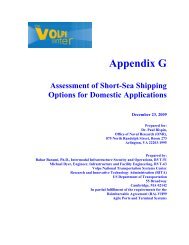Container-on-Barge Pre-Feasibility Study Final Report - Towmasters ...
Container-on-Barge Pre-Feasibility Study Final Report - Towmasters ...
Container-on-Barge Pre-Feasibility Study Final Report - Towmasters ...
Create successful ePaper yourself
Turn your PDF publications into a flip-book with our unique Google optimized e-Paper software.
Marketing efforts to date are likewise insufficient to sustain a multi-port COB service <strong>on</strong><br />
the inland system. This report, however, provides a marketing methodology that would<br />
allow any port <strong>on</strong> the inland system to identify initial demand for COB services at their<br />
port.<br />
While additi<strong>on</strong>al marketing research will be <strong>on</strong>going, the next steps also include a trial or<br />
dem<strong>on</strong>strati<strong>on</strong> project to move c<strong>on</strong>tainers by barge <strong>on</strong> that part of the river system that is<br />
maintained by locks and dams. This is likely the <strong>on</strong>ly way that the chicken and egg<br />
problem described in this report can be resolved.<br />
<strong>Final</strong>ly, the need for federal assistance must be addressed. The ports of Houst<strong>on</strong> and New<br />
York have successfully accessed CMAQ (C<strong>on</strong>gesti<strong>on</strong> Mitigati<strong>on</strong> and Air Quality) funds<br />
that are part of the TEA-21 (Transportati<strong>on</strong> Efficiency Act of the 21 st Century)<br />
legislati<strong>on</strong>. That legislati<strong>on</strong> is currently before the C<strong>on</strong>gress for renewal in the form of<br />
the SAFTEA (Safe, Accessible and Flexible Transportati<strong>on</strong> Act) bill that is generally<br />
much more favorable to freight issues than was TEA-21. SAFTEA maintains the CMAQ<br />
provisi<strong>on</strong>s and includes funding for intermodal c<strong>on</strong>nectors and freight gateways. Uses of<br />
the SAFTEA m<strong>on</strong>ey for COB will likely be justified to the extent that they alleviate<br />
c<strong>on</strong>gesti<strong>on</strong> or air quality issues. If properly structured, COB services would compliment<br />
service by truck or train.<br />
A March 2003 study by the Foundati<strong>on</strong> for Intermodal Research and Educati<strong>on</strong> (FIRE)<br />
showed that c<strong>on</strong>verting a Port of New York to Pittsburgh move from truck to train would<br />
result in a net public benefit of about $53 per truck for a 363 mile trip, or 15 cents per<br />
mile. While no similar studies have been d<strong>on</strong>e for the inland waterway system, at least<br />
this much public saving would be expected if movement were c<strong>on</strong>verted from truck to<br />
barge, thus indicating that the use of CMAQ m<strong>on</strong>ey would be justified for this purpose.
















